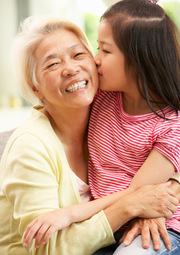Home Safety Tips for Households with Young Children and Elders
Creating a safe and secure living environment for families who are simultaneously caring for young children and aging parents can be challenging. It requires thoughtful planning and often, modifications, to ensure the safety and well-being of everyone in the household.
Join along as we explore practical tips and considerations for implementing home safety modifications that cater to the needs of both generations. Additionally, we will touch on when it may be appropriate to consider alternative living arrangements when safety modifications aren’t sufficient.
Conduct a Comprehensive Safety Assessment
Start by evaluating potential hazards in the home that could pose risks to both young children and elderly parents. Look for tripping hazards, uneven flooring, slippery surfaces, and sharp edges. Take note of areas that require special attention, such as stairs, bathrooms, and kitchen.
Fall Hazards: Identify potential tripping hazards such as loose rugs, cluttered walkways, or uneven flooring. Check for proper lighting in hallways, staircases, and outdoor areas.
Stairs and Railings: Evaluate the condition of stairs, ensuring they are sturdy, have non-slip surfaces, and have handrails on both sides. Install safety gates at the top and bottom of staircases to prevent falls for young children.
Bathroom Safety: Examine the bathroom for potential hazards. Install grab bars near the toilet, bathtub, and shower to assist with stability. Check for non-slip mats or adhesive strips in the bathtub or shower area.
Kitchen Safety: Assess the kitchen for potential dangers. Secure heavy appliances and sharp objects. Store cleaning products and chemicals in locked cabinets. Check for appropriate fire safety measures, such as a fire extinguisher and smoke detectors.
Electrical and Fire Safety: Inspect electrical outlets for safety, ensuring they are in good condition and childproofed if necessary. Ensure smoke detectors and carbon monoxide alarms are present and working properly. Work with qualified electricians to ensure that all parts of your home’s electrical system meet the relevant safety standards.
Bedroom and Sleeping Arrangements: Evaluate the bedroom for safety considerations. Assess the height of the bed and ensure it is easy to get in and out of for elderly parents. Check the stability of bed frames and use bed rails if necessary.
Medication and Poison Safety: Ensure that medications are stored securely and out of reach of children. Evaluate the accessibility and organization of medication supplies. Safely dispose of expired medications.
General Accessibility: Consider the overall accessibility of the home for both elderly parents and young children. Assess doorways, ramps, and ease of movement throughout the house. Evaluate the ease of access to essential items and services.
Emergency Preparedness: Review emergency procedures and ensure that emergency contact information is easily accessible. Evaluate the availability and accessibility of emergency exits and evacuation routes. Develop and practice an emergency evacuation plan with all family members, including elderly parents and young children.
Outdoor Safety: Assess the safety of outdoor areas such as yards, patios, or balconies. Ensure that outdoor spaces are secure and free from hazards like sharp objects or slippery surfaces.
Implement General Safety Measures
When considering the above checklist, here are some specific general safety measures that can be implemented to create a safer environment for the whole family:
- Install and regularly test smoke detectors and carbon monoxide alarms on every level of the home.
- Place fire extinguishers in accessible locations, such as the kitchen, garage, and near fire-prone areas.
- Install childproof locks on cabinets and drawers that contain hazardous substances, sharp objects, or fragile items.
- Use outlet covers or childproof plugs to protect young children from electrical outlets. Alternatively, local electricians can also reposition outlets to safer locations out of the reach of children.
- Keep floors free from clutter and ensure that walkways are clear and well-lit to prevent tripping hazards.
- Secure heavy furniture and appliances to prevent tipping accidents. Use wall anchors or brackets if necessary.
- Enlist the help of a furniture removal service to dispose of bulky items or unused furniture that may pose tripping hazards. Keeping the home clutter-free is essential for maintaining a safe environment for everyone.
- Adjust the water heater temperature to prevent scalding accidents, especially in bathrooms and kitchen sinks.
- Maintain proper lighting throughout the house, especially in hallways, staircases, and outdoor areas.
- Store cleaning products, chemicals, and medications in locked cabinets or high shelves out of reach of children.
- Install window guards or window stops to prevent falls from open windows, especially on upper floors.
- Keep sharp objects such as knives, scissors, and gardening tools stored safely in locked drawers or cabinets.
- Remove or secure loose rugs and ensure that floor coverings are firmly in place to prevent slipping.
- Use corner guards or edge protectors on furniture with sharp edges, especially at child height.
- Create a designated play area for children with safe age-appropriate toys and ensure it is free from potential hazards.
- Use cordless window coverings or secure cords out of reach to prevent strangulation hazards.
- Keep a first aid kit readily available and ensure that everyone in the household knows its location and how to use it.
- Consider additional safety measures that may be needed if your live away from the city in remote areas.
Evaluating Alternative Living Arrangements
No matter how much effort and planning you put into implementing safety modifications, sometimes the individual needs of your elderly parent can necessitate active monitoring and assistance beyond what you can provide at home. If you do have to evaluate long-term care or an assisted living facility for this purpose, it’s important to ask what kinds of modifications and safety precautions have been implemented and what their protocols are for high-risk individuals.
Make informed decisions and seek professional advice to ensure the highest level of safety and care for everyone involved.




